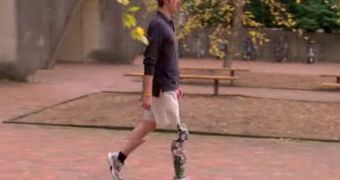A group of experts at the Vanderbilt University announces the development of a prototype bionic leg, which they say is capable of supporting its user in conducting a number of motions that are impossible to do with existing prosthetics.
Researchers already sold the technology to a major prosthetics manufacturer, so we can expect to see it brought to the market within a few years. One of the most important abilities the new device has is that it's somewhat capable of anticipating what the user will do.
For example, there's a specific motion that will tell the bionic leg when it's time to climb some stairs. Another motion will let it know when it's time to climb down. Everything is self-contained, in the sense that the robotic limb includes the battery, computer, actuators and everything else.
The prosthetic device itself is lightweight enough to allow prolonged use. The Vanderbilt team works closely together with shark attack victim Craig Hutto for testing the bionic leg. Hutto lost his leg at the age of 16 and decided to help the science group out.
“I was 16 years old at the time. My brother heard me yell: 'What was that?' He saw something take me under; he saw the back fin of the shark. There was so much tissue damage and so much flesh gone that it was just irreparable,” the student says.
He is now working with VU mechanical engineer Michael Goldfarb's team at the university. Experts are using a grant provided by the US National Science Foundation (NSF) to develop this technology.
“We were able to develop an early prototype that demonstrated that you could have a leg that was light enough and could deliver biomechanical levels of torque and power,” the team leader says.
He adds that the second version of the bionic leg is capable of exhibiting a wider array of motions in the joints, which is ultimately what building a replacement leg is all about. Version 2.0 was funded by the National Institutes of Health (NIH) National Institute of Biomedical Imaging and Bioengineering.
Hutto says that the new machine is a lot more efficient at walking than a conventional prosthetic leg.
“With my leg, it's harder because it's always a step behind. I'm having to use my hip to swing my leg through, whereas the Vanderbilt Powered Prosthetic, when it toes off, the power swings the leg through and so I'm not having to use my hip to swing it through,” he says.
The new technology could be used to help numerous people who suffered from amputations, experts say. The incidence of such occurrences is very high among veterans returning home from the front lines, so this particular subgroup would stand to benefit most from such advanced prosthetics.

 14 DAY TRIAL //
14 DAY TRIAL //